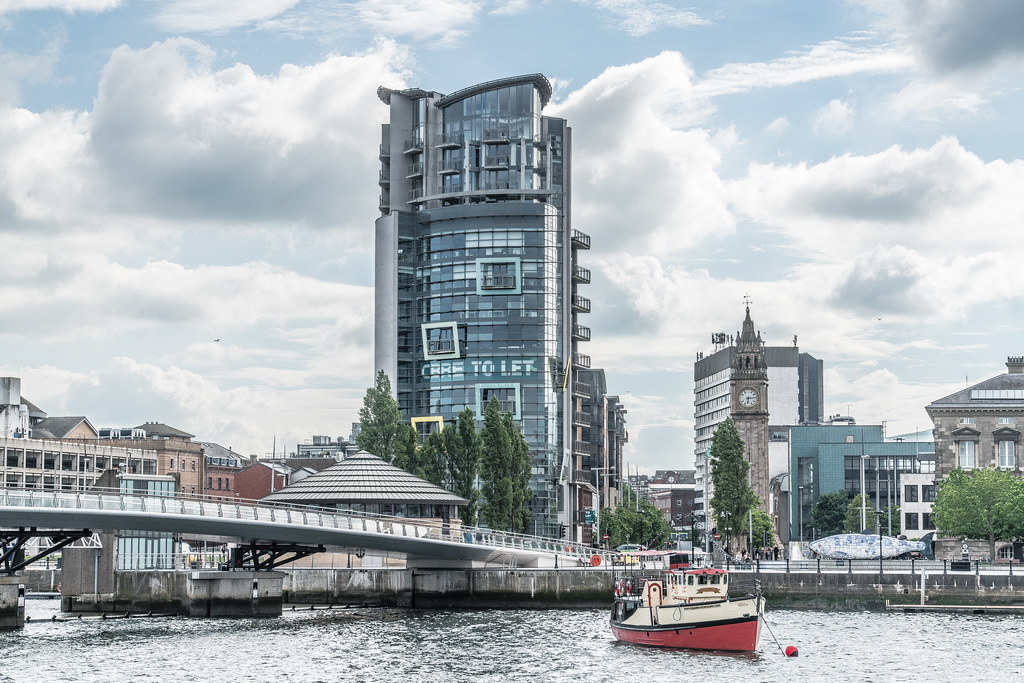THE LAGAN WEIR AND NEARBY 2016
The new Lagan Weir Pedestrian and Cycle Bridge was officially opened on 30 June 2015.
It was still under construction when I visited the city in 2015 but this year I got the opportunity to use and photograph it for the first time. I must admit that I was impressed.
The footbridge connects Donegal Quay with Queen’s Quay, replacing the rather unattractive old footbridge. The new structure consists of structural steel, enveloped in aluminium cladding with a glass parapet on the east elevation and a stainless steel post and wire system on the west parapet.
The Lagan Weir, completed in 1994, at a cost of £14m, is located across the Lagan between the Queen Elizabeth Bridge and the M3 bridge (completed around the same time) in Belfast, Northern Ireland. The Lagan Weir was jointly funded by the Corporation and the European Commission. It was constructed by Charles Brand Ltd and designed by Ferguson and McIlveen.
The weir is a series of massive steel barriers which are raised as the tide retreats to keep the river at an artificially constant level. This improvement to the sewerage system combined with massive dredging of the river by mechanical excavators, and installation of an underwater aeration system, has led to a marked improvement in water quality and the environment around the river. Lagan Weir, dredging and aeration have increased water quality in the river and salmon is returning. An otter and seals have followed the fish that now move up river to spawn in what was once an aquatic death trap.
The objective of the structure is to keep the level of the river artificially constant, as it is a tidal river the level of the water varied by up to three metres between high and low tide. This exposed mudflats which were unsightly and emitted a strong odour, particularly in the summer months. The transformation of the riverside by the construction of the weir has been a catalyst for development along the riverside. Another part of the project is the “Lagan Lookout” centre which explains the history and function of the weir as well as the history of the Lagan itself.
It was still under construction when I visited the city in 2015 but this year I got the opportunity to use and photograph it for the first time. I must admit that I was impressed.
The footbridge connects Donegal Quay with Queen’s Quay, replacing the rather unattractive old footbridge. The new structure consists of structural steel, enveloped in aluminium cladding with a glass parapet on the east elevation and a stainless steel post and wire system on the west parapet.
The Lagan Weir, completed in 1994, at a cost of £14m, is located across the Lagan between the Queen Elizabeth Bridge and the M3 bridge (completed around the same time) in Belfast, Northern Ireland. The Lagan Weir was jointly funded by the Corporation and the European Commission. It was constructed by Charles Brand Ltd and designed by Ferguson and McIlveen.
The weir is a series of massive steel barriers which are raised as the tide retreats to keep the river at an artificially constant level. This improvement to the sewerage system combined with massive dredging of the river by mechanical excavators, and installation of an underwater aeration system, has led to a marked improvement in water quality and the environment around the river. Lagan Weir, dredging and aeration have increased water quality in the river and salmon is returning. An otter and seals have followed the fish that now move up river to spawn in what was once an aquatic death trap.
The objective of the structure is to keep the level of the river artificially constant, as it is a tidal river the level of the water varied by up to three metres between high and low tide. This exposed mudflats which were unsightly and emitted a strong odour, particularly in the summer months. The transformation of the riverside by the construction of the weir has been a catalyst for development along the riverside. Another part of the project is the “Lagan Lookout” centre which explains the history and function of the weir as well as the history of the Lagan itself.

THE NEW LAGAN WEIR IN BELFAST 001
-

THE NEW LAGAN WEIR IN BELFAST 002
-

THE NEW LAGAN WEIR IN BELFAST 003
-

THE NEW LAGAN WEIR IN BELFAST 004
-

THE NEW LAGAN WEIR IN BELFAST 005
-

THE NEW LAGAN WEIR IN BELFAST 006
-

THE NEW LAGAN WEIR IN BELFAST 007
-

THE NEW LAGAN WEIR IN BELFAST 008
-

THE NEW LAGAN WEIR IN BELFAST 009
-

THE NEW LAGAN WEIR IN BELFAST 010
-

THE NEW LAGAN WEIR IN BELFAST 011
-

THE NEW LAGAN WEIR IN BELFAST 012
-

THE NEW LAGAN WEIR IN BELFAST 013
-

THE NEW LAGAN WEIR IN BELFAST 014
-

THE NEW LAGAN WEIR IN BELFAST 015
-

THE NEW LAGAN WEIR IN BELFAST 016
-

THE NEW LAGAN WEIR IN BELFAST 017
-

THE NEW LAGAN WEIR IN BELFAST 018
-

THE NEW LAGAN WEIR IN BELFAST 019
You will find links to buy products from Amazon, Google and other partners. If you click on these links, you’ll find that the URL includes a small extra piece of text which identifies that the click came from my websites. This text is an affiliate code, and it means that I get a small percentage of the money you spend if you choose to buy that product, or, in some cases, other products from the site soon after. These affiliate links help pay the costs of producing my websites and ensure that the content is free to you.

















